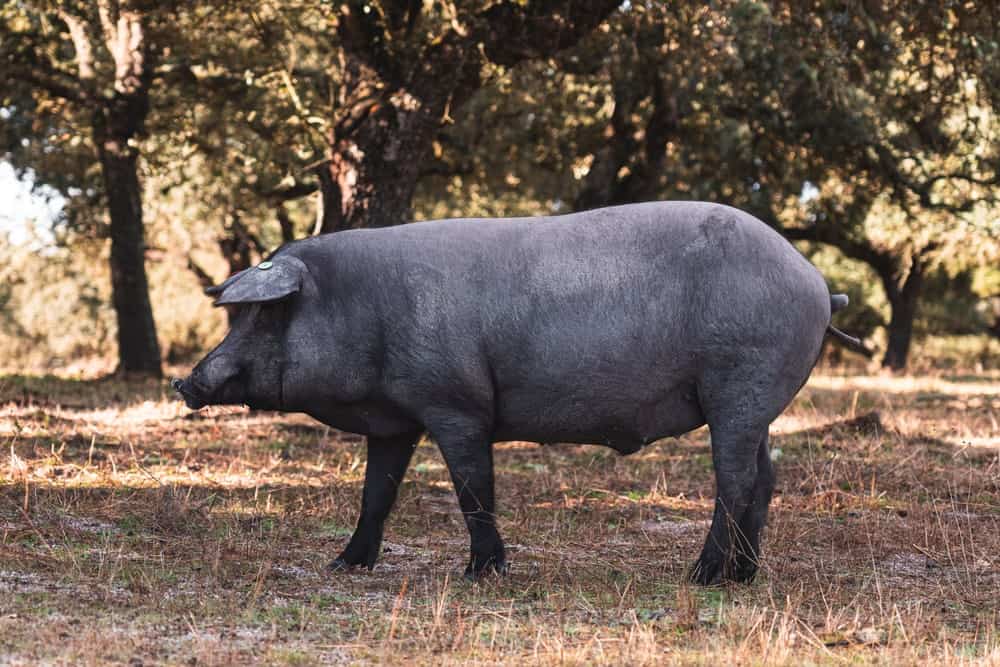Hailing from the Iberian Peninsula, Iberian pigs are typically raised for meat. This pig breed’s lineage dates back to the Neolithic era, when animals were first being domesticated. These pigs are now adapted to domestic life and can happily exist in pastures or grazing areas throughout the year. Here is what you should know about the uses, origins, and characteristics of the Iberian Pig.

Quick Facts about Iberian Pigs

| Breed Name: | Iberian |
| Place of Origin: | Iberian Peninsula |
| Uses: | Meat, pets |
| Male Size: | 33 – 38 inches |
| Female Size: | 20 – 33 inches |
| Color: | Black, brown, grey, red, orange |
| Lifespan: | 12 months to 4 years |
| Climate Tolerance: | Mild, temperate, tropical |
| Care Level: | Medium |
| Production: | High |
Iberian Pig Origins
These pigs come from the Iberian Peninsula, where they thrive on the land. It is said that they were brought to the Peninsula by Phoenicians via Lebanon. Afterward, they were bred with wild boars, which created the Iberian breed that we all know and love today. In places like the Mediterranean, these pigs serve to enhance the ecosystem and work as part of the natural cycle of food production. In other parts of the world, they are simply bred for slaughter and sale.
Iberian Pig Characteristics
These intelligent animals have long snouts and ears, sturdy legs, and pot bellies. They still carry wild characteristics, like running away from people and perceived threats. However, they have adapted to living with humans, and they can become great friends if they are closely engaged throughout their lives.
These pigs can learn tricks, figure out puzzles, and even cuddle on the couch if allowed. Most Iberian pigs are raised for meat, though, so they do not get an opportunity to interact and live with humans, and many people do not recognize this pig breed’s abilities.
Uses
The Iberian pig is typically used for meat. In many parts of the world, this pig makes up a large part of animal protein in people’s diets. They are raised just for food, and although they can live several years naturally, they are typically slaughtered by the age of 16 months to become food.
Appearance & Varieties
These pigs are semi-wild in nature, so they are not popular in the pet realm. These animals are dark in color, stout, and active. They have long, floppy ears and well-defined snouts. They can smell things from a mile away, and they are not picky when it comes to mealtime.
Population/Distribution/Habitat
Even though there is no official population count, we know that the Iberian pig population is not great. These pigs are usually raised for meat in small communities and are not widely distributed throughout the world.
These are not the types of pigs that large commercial manufacturers focus on, but rather they are popular among indigenous communities that have few other food-growing options to choose from throughout the year.
- Related Read: 8 Best Sheep Breeds for Meat
Are Iberian Pigs Good for Small-Scale Farming?
Iberian pigs are ideal for small-scale farming. They do not take up much space, they are happy to live in fenced grazing areas, and they require little to no grooming until they are ready for slaughter. These pigs do drink a large amount of water and require daily rationings, but the weight in meat that is reciprocated after slaughter is usually well worth the work put into the animal.

Final Thoughts
Iberian pigs are great for small-scale farmers who want to raise their own meat. These animals can also make good pets, but they must be socialized from a young age due to their wild nature. They are playful, interactive, smart, and curious. However, they can be unpredictable and a pain if not taken care of properly. What are your thoughts about this interesting breed of pig?
Featured Image Credit: Josue Acosta Quintanilla, Shutterstock
